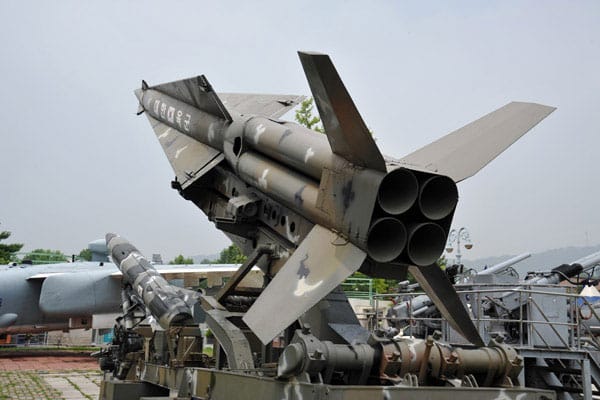The NHK-1 (Nike Hercules Korea 1) was a short-range, solid-fueled ballistic missile. It was reverse-engineered from the U.S. MIM-14 Nike Hercules, from which it derives its name. The NHK-1 was the first ballistic missile indigenously produced in South Korea. It had a range of 180 km.
NHK-1 at a Glance
- Originated from
- South Korea, United States
- Possessed by
- South Korea
- Alternative names
- K-1, Baekgom-1, Paekkom-1 (‘white bear’)
- Class
- Short-range ballistic missile (SRBM)
- Basing
- Road-mobile
- Length
- 12.2-12.5 m
- Diameter
- 0.8 m
- Launch weight
- 5,400 kg
- Payload
- Unitary warhead, 500 kg
- Warhead
- High explosive (HE)
- Propulsion
- Two-stage, solid propellant
- Range
- 180 km
- Status
- Obsolete
- In service
- 1978-1987

NHK-1 on display.
NHK-1 Development
Starting in the early 1970s, South Korea (ROK) began development of a short-range ballistic missile program aimed at countering the North Korean threat.1
In 1972, South Korea obtained U.S. permission to reverse-engineer a U.S. MIM-14 Nike Hercules surface-to-air missile. The state-owned Agency for Defense Development successfully did so in 1975.2
After several modifications, the resulting surface-to-surface missile was designated the NHK-1, also commonly referred to as Baekgom (translation: “white bear”).3
After three failed missile tests, South Korea successfully test fired the missile in September 1978.4
Specifications
The NHK-1 had a length of over 12 m, a diameter of 0.8 m, and a launch weight of approximately 5,400 kg. The missile was solid-fueled, two-staged, with a range of 180 km while carrying a 500 kg high explosive warhead.5
Service History
The NHK-1 missile was prepared to enter operational service in 1978, but was never deployed at the request of the United States, likely due to arms control and regional proliferation concerns. 6 It was replaced by the NHK-2/Hyunmoo-1 SRBM.
Footnotes
- Anthony H. Cordesman, “Korean Missile Forces (Working Draft),” CSIS, (Washington, DC: CSIS, November 7, 2016), 29, https://csis-prod.s3.amazonaws.com/s3fs-public/publication/161108_AHC_Korean_Missile_Forces.pdf.
- Zachary Keck, “North Korea Isn’t the Only Korea with Killer Missiles,” The National Interest, July 8, 2017, http://nationalinterest.org/blog/the-buzz/north-korea-isnt-the-only-korea-killer-missiles-21469.
- The Hyunmoo-2C: South Korea’s 800km Missile, Arms Control Wonk Podcast, June 30, 2017, http://armscontrolwonk.libsyn.com/the-hyunmoo-2c-south-koreas-800km-missile.
- Tae-Hyung Kim, “South Korea’s space policy and its national security implications,” Korean Journal of Defense Analysis, December 10, 2010, 11, http://www.tandfonline.com/doi/abs/10.1080/10163271.2010.519935?src=recsys&journalCode=rkjd20.
- Zachary Keck, “North Korea Isn’t the Only Korea with Killer Missiles” and “Nike-Hercules variant” in IHS Jane’s Weapons: Strategic 2015-2016, ed. James C. O’Halloran (United Kingdom: IHS, 2015), 68-69.
- Tae-Hyung Kim, “South Korea’s space policy and its national security implications,” 11.